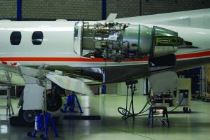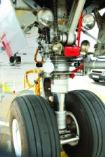Move forward and embrace further changes in the future – it’s all about agility.
The civil aviation support industry is changing quickly and dramatically – from the advent of new composite materials such as carbon fiber and super-alloys to advanced in-flight entertainment, combined with a growing number of commoditized and therefore disposable items – each of these bring widely different Maintenance, Repair and Overhaul (MRO) demands.
Just how can all parties involved in MRO adapt and remain competitive in a landscape of rapidly advancing technologies?
 Given the growing number of aircraft in service today and how critical passenger safety is – Visiongain predicts that the value of the commercial aircraft MRO market in 2014 will reach a huge $53.4bn – MRO has to evolve to stay ahead of the curve. The manually-driven spreadsheets of old are just not up to the job.
Given the growing number of aircraft in service today and how critical passenger safety is – Visiongain predicts that the value of the commercial aircraft MRO market in 2014 will reach a huge $53.4bn – MRO has to evolve to stay ahead of the curve. The manually-driven spreadsheets of old are just not up to the job.
Driving these changes is a demanding market which is increasingly driven by a need to improve fuel efficiency and reduce costs wherever possible. Combine this with the fact that some OEMs are starting to offer MRO themselves – particularly where they supply a state-of-the-art part – and that some airlines are beginning to reduce outsourced work by bringing maintenance back in-house, and it is clear that third-party MRO compani
es must keep up.
It is through new mobile applications combined with an agile ERP support solution, that MRO shops will be able to keep up with the pace of change, helping them to move forward and embrace further changes in the future.
Complexity Looking for a Simple Solution
 Third-party MRO organizations in particular need to have a comprehensive support solution in place to manage and track certain processes – such as where particular parts are in their lifecycle, the cannibalization of another aircraft, or how certain suppliers are performing.
Third-party MRO organizations in particular need to have a comprehensive support solution in place to manage and track certain processes – such as where particular parts are in their lifecycle, the cannibalization of another aircraft, or how certain suppliers are performing.
The more holistic an ERP solution is, the more simple it becomes to extract management information in order to track these processes successfully.
And being able to integrate data and metrics is key – for example tracking the cost of labor versus the cost of an individual component, all cross-referenced to the need for the plane to be returned to service at a certain time. Correct MRO decisions can then be made on whether to replace, repair or buy-in. In order to achieve this visibility, and for smaller MRO shops to remain compliant with the requirements of larger airlines, all data must be integrated – again requiring a holistic view.
Mobile Smart Devices in Today’s Market
Nowhere is the use of smart devices more practical than in the aircraft MRO world, offering more opportunity to leverage the huge investments made by businesses in enterprise support systems.
In an age of the ‘bring your own device’ (BYOD) trend, mobile applications, can help avoid costly or extensive training. Today’s generation of MRO engineers grew up with computers in the home, cell phones, and more recently smartphones and tablets, and are therefore well versed in how such technology works.
MRO in civil aviation works with a lot of paper maintenance manuals – a mobile app offers these on a device in a technician’s pocket. These devices enable work to become more interactive, more interesting, and arguably more effective with the inclusion of videos and 360 degree rotational images. Tablets are naturally adaptable to the support of general MRO, giving the technician the ability to approve a work order, view stock availability or check repair history at the touch of a screen.
Agility is The Answer

Download this whitepaper on the pivotal role of mobile devices in the dramatically changing market of Civil Aviation MRO.
Mobile devices offer a window to the broad based ERP software, its maintenance processes, sign-off, supply chain and configuration management. In short, a mechanic can target the exact information he or she needs to carry out a repair at any location, follow a rigorous MRO process, whether it’s within a sprawling hangar complex, or on a tarmac at a remote location.
Mobile applications combined with a sophisticated ERP support solution will help MRO shops to keep up with the pace of change we are currently seeing in the market, and help them to move forward and embrace further changes in the future – it’s all about agility.
To learn more about our view on the role of innovative technology in MRO, download our new whitepaper, “Civil Aviation MRO – The Pivotal Role of Mobile in a Dramatically Changing Market.”